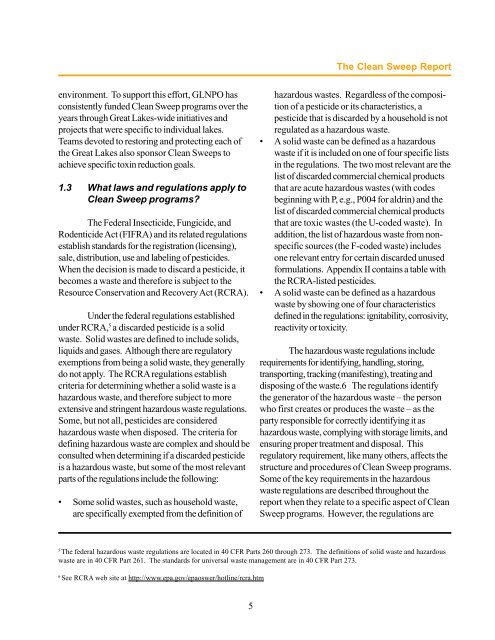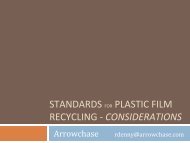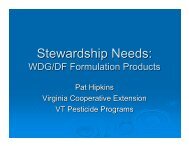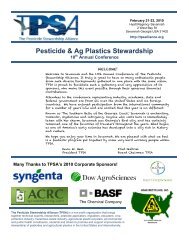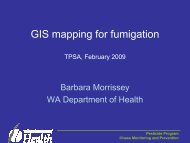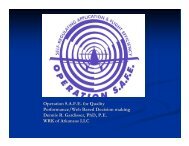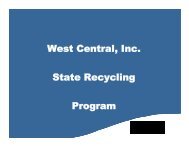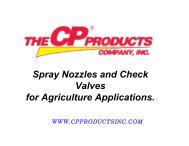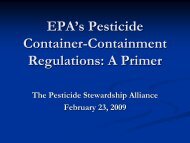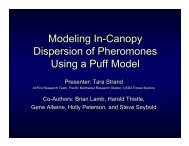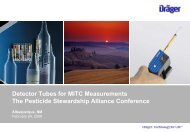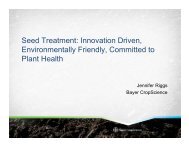Clean Sweep Programs - US Environmental Protection Agency
Clean Sweep Programs - US Environmental Protection Agency
Clean Sweep Programs - US Environmental Protection Agency
- No tags were found...
You also want an ePaper? Increase the reach of your titles
YUMPU automatically turns print PDFs into web optimized ePapers that Google loves.
The <strong>Clean</strong> <strong>Sweep</strong> Reportenvironment. To support this effort, GLNPO hasconsistently funded <strong>Clean</strong> <strong>Sweep</strong> programs over theyears through Great Lakes-wide initiatives andprojects that were specific to individual lakes.Teams devoted to restoring and protecting each ofthe Great Lakes also sponsor <strong>Clean</strong> <strong>Sweep</strong>s toachieve specific toxin reduction goals.1.3 What laws and regulations apply to<strong>Clean</strong> <strong>Sweep</strong> programs?The Federal Insecticide, Fungicide, andRodenticide Act (FIFRA) and its related regulationsestablish standards for the registration (licensing),sale, distribution, use and labeling of pesticides.When the decision is made to discard a pesticide, itbecomes a waste and therefore is subject to theResource Conservation and Recovery Act (RCRA).Under the federal regulations establishedunder RCRA, 5 a discarded pesticide is a solidwaste. Solid wastes are defined to include solids,liquids and gases. Although there are regulatoryexemptions from being a solid waste, they generallydo not apply. The RCRA regulations establishcriteria for determining whether a solid waste is ahazardous waste, and therefore subject to moreextensive and stringent hazardous waste regulations.Some, but not all, pesticides are consideredhazardous waste when disposed. The criteria fordefining hazardous waste are complex and should beconsulted when determining if a discarded pesticideis a hazardous waste, but some of the most relevantparts of the regulations include the following:• Some solid wastes, such as household waste,are specifically exempted from the definition ofhazardous wastes. Regardless of the compositionof a pesticide or its characteristics, apesticide that is discarded by a household is notregulated as a hazardous waste.• A solid waste can be defined as a hazardouswaste if it is included on one of four specific listsin the regulations. The two most relevant are thelist of discarded commercial chemical productsthat are acute hazardous wastes (with codesbeginning with P, e.g., P004 for aldrin) and thelist of discarded commercial chemical productsthat are toxic wastes (the U-coded waste). Inaddition, the list of hazardous waste from nonspecificsources (the F-coded waste) includesone relevant entry for certain discarded unusedformulations. Appendix II contains a table withthe RCRA-listed pesticides.• A solid waste can be defined as a hazardouswaste by showing one of four characteristicsdefined in the regulations: ignitability, corrosivity,reactivity or toxicity.The hazardous waste regulations includerequirements for identifying, handling, storing,transporting, tracking (manifesting), treating anddisposing of the waste.6 The regulations identifythe generator of the hazardous waste – the personwho first creates or produces the waste – as theparty responsible for correctly identifying it ashazardous waste, complying with storage limits, andensuring proper treatment and disposal. Thisregulatory requirement, like many others, affects thestructure and procedures of <strong>Clean</strong> <strong>Sweep</strong> programs.Some of the key requirements in the hazardouswaste regulations are described throughout thereport when they relate to a specific aspect of <strong>Clean</strong><strong>Sweep</strong> programs. However, the regulations are5The federal hazardous waste regulations are located in 40 CFR Parts 260 through 273. The definitions of solid waste and hazardouswaste are in 40 CFR Part 261. The standards for universal waste management are in 40 CFR Part 273.6See RCRA web site at http://www.epa.gov/epaoswer/hotline/rcra.htm5


